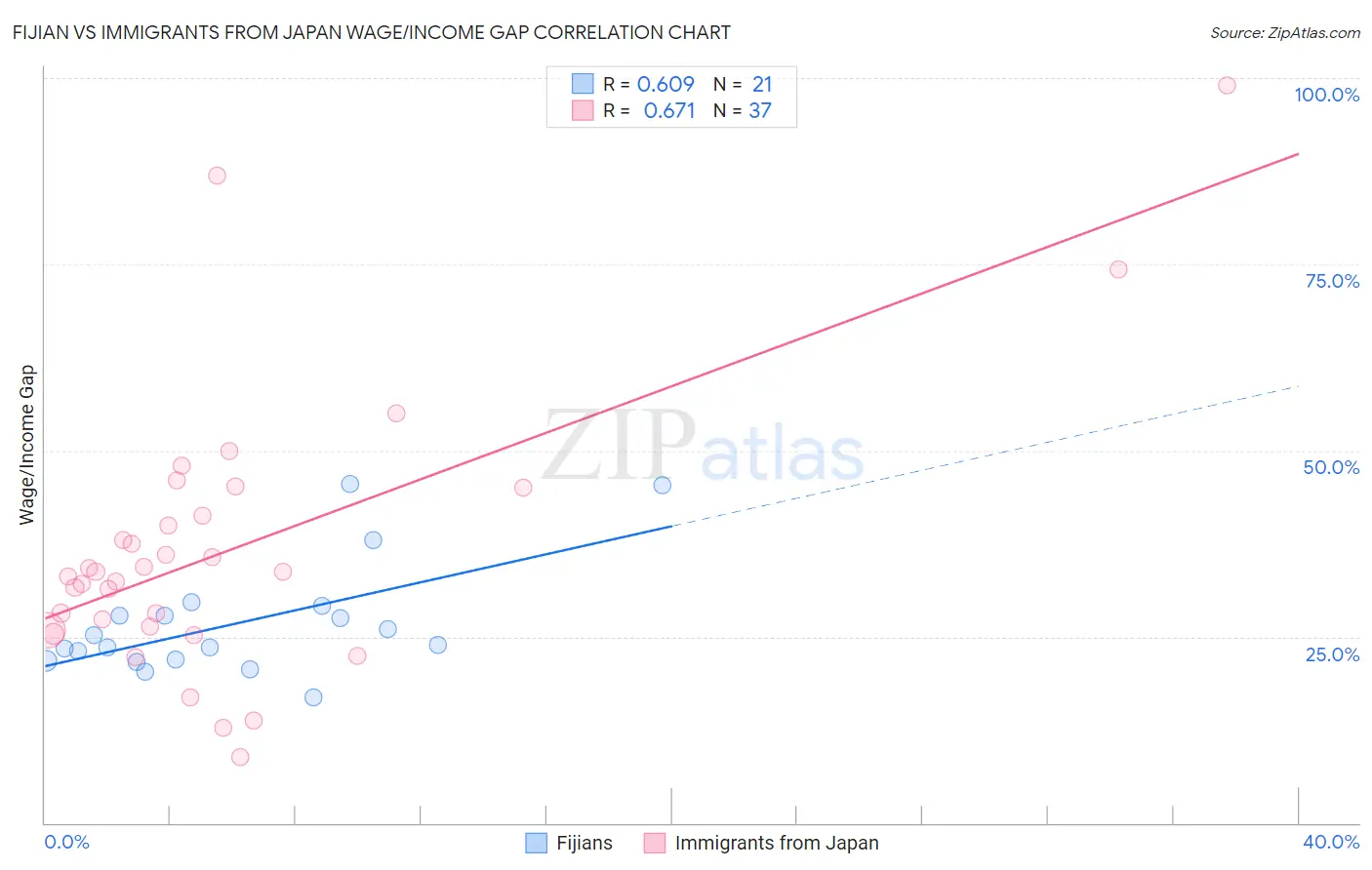Fijian vs Immigrants from Japan Wage/Income Gap
COMPARE
Fijian
Immigrants from Japan
Wage/Income Gap
Wage/Income Gap Comparison
Fijians
Immigrants from Japan
22.9%
WAGE/INCOME GAP
99.9/ 100
METRIC RATING
75th/ 347
METRIC RANK
27.9%
WAGE/INCOME GAP
0.7/ 100
METRIC RATING
275th/ 347
METRIC RANK
Fijian vs Immigrants from Japan Wage/Income Gap Correlation Chart
The statistical analysis conducted on geographies consisting of 55,941,017 people shows a significant positive correlation between the proportion of Fijians and wage/income gap percentage in the United States with a correlation coefficient (R) of 0.609 and weighted average of 22.9%. Similarly, the statistical analysis conducted on geographies consisting of 339,998,398 people shows a significant positive correlation between the proportion of Immigrants from Japan and wage/income gap percentage in the United States with a correlation coefficient (R) of 0.671 and weighted average of 27.9%, a difference of 21.6%.

Wage/Income Gap Correlation Summary
| Measurement | Fijian | Immigrants from Japan |
| Minimum | 16.8% | 8.9% |
| Maximum | 45.5% | 99.0% |
| Range | 28.7% | 90.1% |
| Mean | 26.8% | 36.7% |
| Median | 23.9% | 33.6% |
| Interquartile 25% (IQ1) | 21.9% | 26.1% |
| Interquartile 75% (IQ3) | 28.5% | 43.1% |
| Interquartile Range (IQR) | 6.6% | 17.0% |
| Standard Deviation (Sample) | 7.6% | 18.4% |
| Standard Deviation (Population) | 7.4% | 18.2% |
Similar Demographics by Wage/Income Gap
Demographics Similar to Fijians by Wage/Income Gap
In terms of wage/income gap, the demographic groups most similar to Fijians are Ecuadorian (22.9%, a difference of 0.010%), African (22.9%, a difference of 0.15%), Nigerian (23.0%, a difference of 0.25%), Immigrants from Burma/Myanmar (22.8%, a difference of 0.28%), and Immigrants from Nicaragua (23.0%, a difference of 0.34%).
| Demographics | Rating | Rank | Wage/Income Gap |
| Immigrants | Nigeria | 99.9 /100 | #68 | Exceptional 22.7% |
| Indonesians | 99.9 /100 | #69 | Exceptional 22.7% |
| Immigrants | Uzbekistan | 99.9 /100 | #70 | Exceptional 22.7% |
| Immigrants | El Salvador | 99.9 /100 | #71 | Exceptional 22.8% |
| Sub-Saharan Africans | 99.9 /100 | #72 | Exceptional 22.8% |
| Immigrants | Eastern Africa | 99.9 /100 | #73 | Exceptional 22.8% |
| Immigrants | Burma/Myanmar | 99.9 /100 | #74 | Exceptional 22.8% |
| Fijians | 99.9 /100 | #75 | Exceptional 22.9% |
| Ecuadorians | 99.9 /100 | #76 | Exceptional 22.9% |
| Africans | 99.9 /100 | #77 | Exceptional 22.9% |
| Nigerians | 99.9 /100 | #78 | Exceptional 23.0% |
| Immigrants | Nicaragua | 99.9 /100 | #79 | Exceptional 23.0% |
| Salvadorans | 99.9 /100 | #80 | Exceptional 23.0% |
| Bermudans | 99.8 /100 | #81 | Exceptional 23.1% |
| Central Americans | 99.8 /100 | #82 | Exceptional 23.1% |
Demographics Similar to Immigrants from Japan by Wage/Income Gap
In terms of wage/income gap, the demographic groups most similar to Immigrants from Japan are Lebanese (27.9%, a difference of 0.030%), Latvian (27.9%, a difference of 0.030%), American (27.8%, a difference of 0.080%), Immigrants from England (27.9%, a difference of 0.11%), and Bulgarian (27.8%, a difference of 0.12%).
| Demographics | Rating | Rank | Wage/Income Gap |
| New Zealanders | 1.0 /100 | #268 | Tragic 27.7% |
| Potawatomi | 0.9 /100 | #269 | Tragic 27.7% |
| Immigrants | Western Europe | 0.9 /100 | #270 | Tragic 27.8% |
| Ute | 0.8 /100 | #271 | Tragic 27.8% |
| Immigrants | Korea | 0.8 /100 | #272 | Tragic 27.8% |
| Bulgarians | 0.7 /100 | #273 | Tragic 27.8% |
| Americans | 0.7 /100 | #274 | Tragic 27.8% |
| Immigrants | Japan | 0.7 /100 | #275 | Tragic 27.9% |
| Lebanese | 0.7 /100 | #276 | Tragic 27.9% |
| Latvians | 0.7 /100 | #277 | Tragic 27.9% |
| Immigrants | England | 0.6 /100 | #278 | Tragic 27.9% |
| Romanians | 0.5 /100 | #279 | Tragic 28.0% |
| Russians | 0.5 /100 | #280 | Tragic 28.0% |
| Burmese | 0.5 /100 | #281 | Tragic 28.0% |
| South Africans | 0.5 /100 | #282 | Tragic 28.0% |